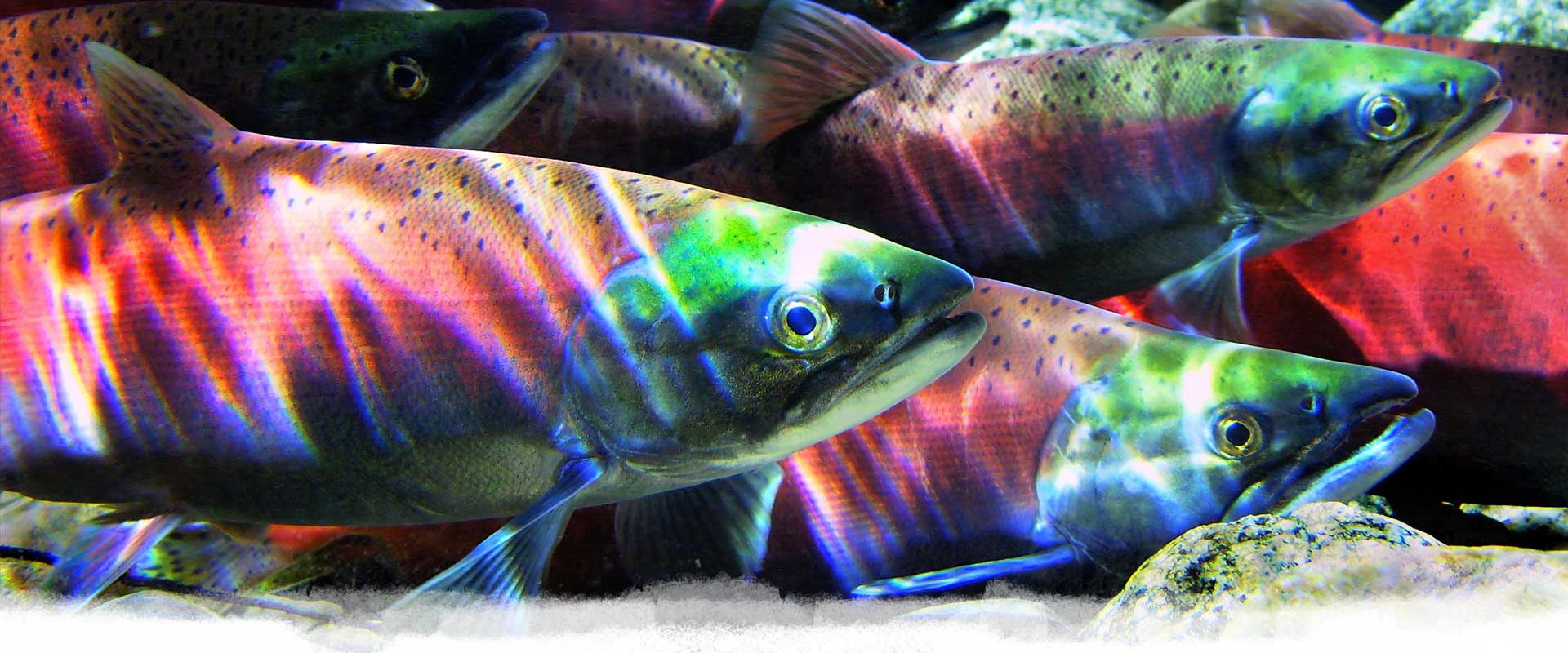
Shoreline Restoration
Kokanee habitat restoration, wetland restoration and beach cleanups
HEALTHY SHORELINES
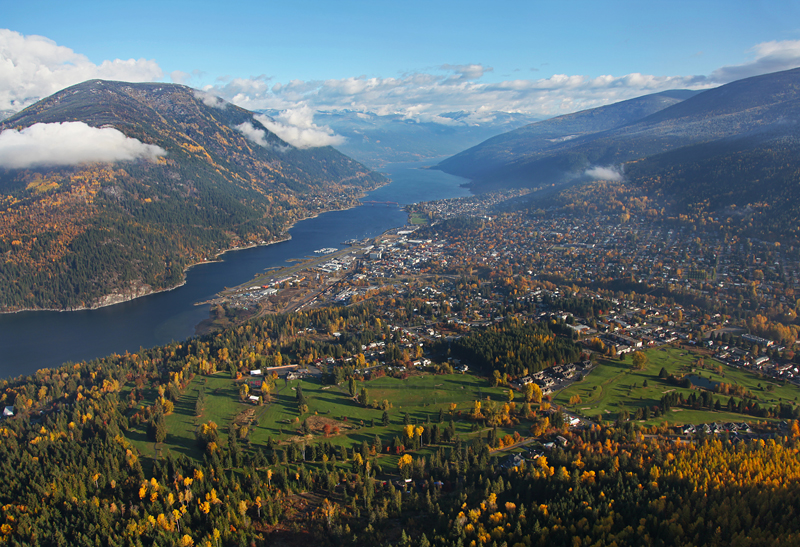
Photo Credit: Douglas Noblet
Shoreline homeowners have a huge role to play in the health of the lake. The trend of altering shorelines to include groomed beaches, imported sand, retaining walls, etc. can be harmful to the lake. Homeowners may not think that by altering their small section of shoreline can have any impact, but it is important to remember that many people may be doing the same thing. If the cumulative effects of altered shorelines can result in “death by a thousand cuts” we believe our lake can be healed by a thousand Band-Aids.
For information on how to convert your altered shoreline to a natural one or how to meet your needs as a homeowner but keep your shoreline healthy click here to see the Homeowners Resources section of our site.
SHORE-SPAWNING KOKANEE HABITAT RESTORATION
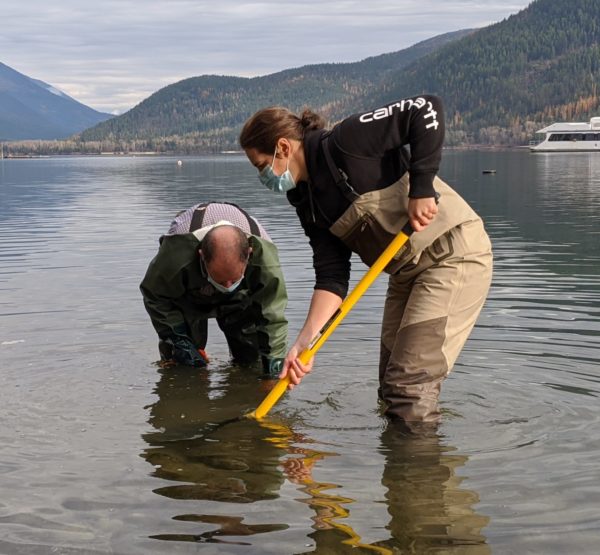
Shore-spawning kokanee salmon are a genetically distinct species of kokanee is Kootenay Lake. Shore Spawning Kokanee numbers in the West Arm are declining, which Martin (1979) and Andrusak and Northcote (1989) suggest
is attributed to changes in the hydrograph due to hydroelectric operations
(Irvine, Andrusak and Andrusak 2012). Shore-spawning kokanee redds become dewatered as lake levels are lowered in early spring, fatally stranding fry on shore.
This project focuses on collecting data and restoring habitat for Shore Spawning Kokanee in Kootenay Lake’s West Arm. Gravel installed at a lower elevation than current rearing habitat will encourage Kokanee to spawn at elevations unaffected by fluctuations in the hydrograph. It is expected that Kokanee will show a preference for restored habitat, reducing the risk of redds being de-watered in the spring.
Timeline of events
- Sept 2020: Ideally sized spawning gravel was placed below the low water mark at McDondalds Landing Regional Park in attempt to encourage spawning kokanee to lay eggs at lower elevations.
- Sept – Nov 2020: FoKLSS and Ministry of FLNRORD staff monitored spawning kokanee numbers and behavior.
- Nov 2020: egg capsules containing kokanee eggs were placed at varying elevations within the study and control site in attempt to assess egg-to-fry survival.
- Feb 2021: Egg capsules were removed, revealing high egg mortality, indicating that the modified egg capsules disallowed adequate oxygen diffusion.
- Mar 2021: We conducted a dewatered redd survey with the ministry of FLRNORD fisheries staff at the restoration site as well as at other spawning sites in the 6-mile area. 80-90% redd dewatering was observed at all sites, except the restored site contained an estimated 70% dewatered redds.
- Apr 2021: Gravel maintenance was performed where gravel was raked smooth to reduce clumping and pushed deeper into the water.
- Apr 2021: Seepage metres were placed within the gravel at the study site and tested in preparation for our groundwater monitoring study that will take place over the winter of 2021/22.
Looking ahead:
-
- Groundwater monitoring at the restoration site will help us to understand groundwater discharge at varying elevations and kokanee’s groundwater preferences at the restoration site
- We will continue to monitor spawning kokanee at the restoration site each fall into the foreseeable future
- We will continue to conduct dewatered redd surveys at the restoration site into the foreseeable future
Ways to Support Shore Spawning Kokanee Populations:
- Learn about the agreements, treaties and commissions that govern hydroelectric operations on Kootenay LakeAvoid disturbance in known spawning areas between September and May of each year.
- Keep beaches natural – kokanee require gravel to build redds, and by creating manmade sandy beaches, you are contributing to habitat loss for this fragile species.
- Keep it clean –replace your degrading unencapsulated polystyrene foam docks with encapsulated or non-foam based float docks, as polystyrene contains toxic, carcinogenic compounds and crumble into microplastics that are impossible to remove. Degrading and polluting structures are illegal, so you’d better take care of it before the authorities do!
- Submit your sightings of spawning kokanee to our lake observation page!
- Donate or become a member of Friends of Kootenay Lake and help us achieve our vision of a healthy, thriving lake for generations to come
HARROP WETLAND RESTORATION
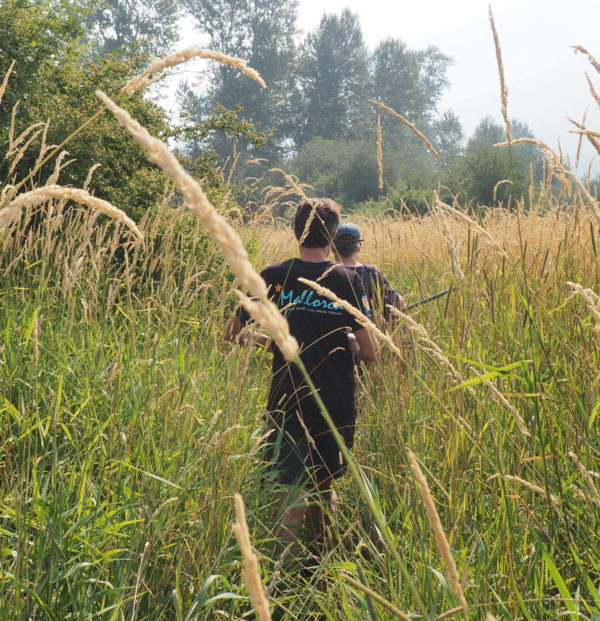
The Harrop wetland complex is located in Sunshine Bay Regional Park in Harrop, BC. The wetland consist of a series of ephemeral wetlands, meaning holding water only part of the year, and serve as a breeding site for western toad.
In 2013, FoKLSS was contacted by concerned community members in the Harrop area regarding mass die-offs of western toad tadpoles due to insufficient wetland pond water levels, ATV “mud bogging” activity in the sensitive habitat, and about dogs killing wildlife in the area.
Timeline of events
- 2014 – FoKLSS conducted extensive community outreach and brought on wildlife biologists and wetland designers to create a restoration design for the wetlands.
- 2014 – FoKLSS completed restoration work which included excavating deeper pools, blocking the outflow, planting native vegetation, installing bat boxes, bird boxes and a snake hibernaculum. FoKLSS hosted an amphibian monitoring workshop with Herpetologist Jakob Dulisse training citizen scientists to monitor the ponds for amphibian activity and restoration success.
- 2014-2019 – two citizen scientists monitored the pools/amphibians regularly, submitting data to FoKLSS.
- 2020 – ongoing concerns outlined in data brought FOKLSS to reinvigorate the program in 2021.
- Apr 2021 – FoKLSS received funding from Columbia Power and the Kootenay Lake Local Conservation Fund (KLLCF) to conduct monitoring/assessments and bring on Tom Biebighauser to create an updated site prescription.
- March 2021 – Selkirk College students attended an education day at the site.
- May 2021 – Kat McGlynn hosted an updated amphibian monitoring workshop at the site where we trained three additional monitors and set them up on a monitoring schedule.
- June 2021 – FoKLSS hosted a Harrop Community Meeting where we gathered community feedback regarding continued work at the site. See the meeting recording here.
- Summer 2021 – Kootenay Lake levels were not high enough to breach the inflow of the wetland. The ponds did not fill up with any water at all for the first time since the project’s inception.
5 years of monitoring data suggest more action is required to ensure the ponds serve as a population source for western toad (low pond levels in dry years, high predation, development abnormalities noted)
- FoKLSS will work with a research hydrologist to install groundwater monitoring equipment at the site
- FoKLSS will collect water quality samples to be assessed at Passmore Laboratories
- Wetland designer Tom Biebighauser will visit the site around August 1st where we will record elevations using a laser level, identify actions that will help us meet our objectives for the site (such as potentially lowering the outflow to allow inundation in low-water years), and examine areas for potential additional restoration activities. Tom will develop a site prescription for continued work
- Citizen scientists will continue to monitor regularly
BEACH AND LAKEBED CLEANUPS
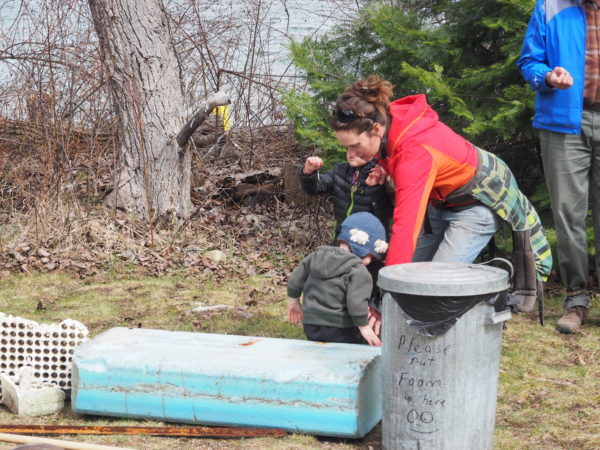
By cleaning beaches and areas of lakebed, we hope to lessen garbage and polystyrene foam pollution around Kootenay Lake while bringing attention to garbage pollution sources and solutions. We conduct multiple volunteer supported beach or shoreline cleanups all around Kootenay Lake annually. In 2020 we conducted our first lakebed cleanup with the help of volunteer divers. These cleanup events are especially exciting as it’s always a mystery what the divers will hook next! We will continue conducting cleanups of Kootenay Lake’s lakebed at popular marinas and water access locations into the foreseeable future.
Share with us your thoughts and ideas on the Harrop Wetland Restoration project by filling out the form below:
